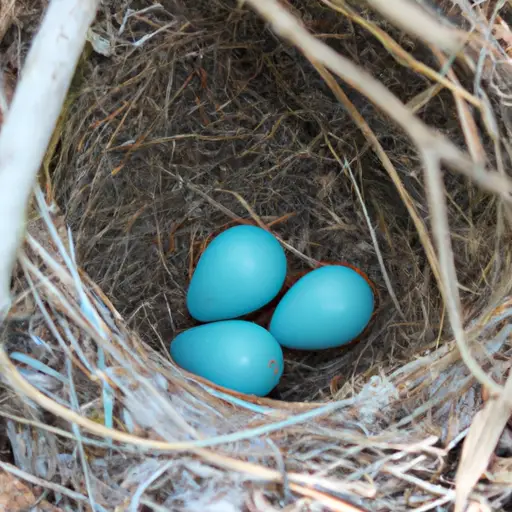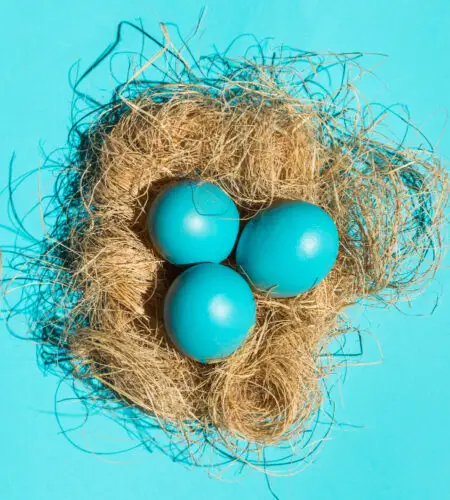Introduction
Have you ever wondered what bird lays blue eggs? Well, you’re in the right spot to find out!
This article talks about the fascinating world of birds with blue eggs. We’ve covered everything from the well-loved American Robin to the less-known but equally interesting species.
You’ll learn why these eggs are blue, what bird lays blue eggs, and how recognizing them can tell you a lot about the bird that laid them. So, let’s get started and unravel the mystery behind blue eggs!

The Mystery of Blue Eggs: what bird lays blue eggs?
Why do some birds lay blue eggs? It’s all down to science. The color of an egg’s shell is determined by the substances the bird secretes while the egg is being formed. But, when we’re talking about what bird lays blue eggs, the most famous bird that comes to mind is the American Robin.
The Robin: America’s Favorite Blue Egg Layer
Let’s chat about the American Robin for a minute. This bird is pretty much everyone’s backyard buddy. Have you seen those beautiful blue eggs nestled in nests around your home? Those are most likely robin eggs.
Robins are not shy; they might even set up shop right on your porch if it feels right. Usually, a robin’s nest will have about three to five of these eye-catching blue eggs. And guess what? It only takes around two weeks for them to hatch. Imagine that—two weeks!
Robins are part of what makes looking out your window or sitting on your deck so special. They bring a bit of wildlife right to your doorstep. It’s like they’re sharing a little piece of their world with us. Plus, spotting those blue eggs? It’s like a mini treasure hunt right in your backyard.
So, when you’re out and about or just looking around your garden, keep an eye out for these friendly birds and their beautiful blue gifts.
It’s a simple joy, but it reminds us of the beauty of nature that’s all around us if we just take the time to look.

Beyond Robins: Other Birds That Lay Blue Eggs
Now, while the American Robin might be the most famous for its stunning blue eggs, it’s not the only bird in the blue egg club. Enter the Bluebirds, Starlings, and Blackbirds—each of these birds also lays blue eggs, and they’ve got their own styles and favorite spots for building nests.
Bluebirds, for instance, love open spaces and will often nest in birdhouses or tree cavities. Their eggs are a bright, beautiful blue, a bit like looking into a clear sky on a sunny day.
Starlings, on the other hand, are a bit more urban. They’re the ones taking up residence in the nooks and crannies of buildings and are a bit more rugged in where they lay their blue eggs. And Blackbirds? Their nests are a bit more hidden, tucked away in dense shrubs or trees, making their blue eggs a rare find for the keen-eyed observer.
Getting to know these birds and where they like to hang out can turn your next walk in the park or even just a day in the backyard into an exciting expedition.
You’re not just looking at birds; you’re uncovering a piece of the puzzle of nature. Each nest you spot is a story, a little secret shared between you and the birds. So, keep those eyes peeled for blue eggs and the amazing birds that lay them.
It’s a wonderful way to connect with the natural world and learn something new, don’t you think?
The Significance of Egg Color
Why Blue? The Science Behind Egg Coloration
why some birds go for blue when it comes to their eggs? It’s not just a fashion choice; there’s real science behind it. These blue shells do more than look pretty; they’re nature’s way of keeping the eggs safe.
Imagine a nest tucked away in a bush. Blue eggs can blend in with the sky and shadows, making it harder for sneaky predators to spot them. also, the color isn’t just for show. Research suggests blue might keep harmful germs at bay, giving those little chicks a better shot at life.
It’s all about survival, and that splash of blue is a bird’s clever trick to protect its future brood. So, the next time you spot a blue egg, remember, it’s nature working its magic in the most colorful ways.
Tips for Identifying Birds with Blue Eggs
Guessing which bird laid those blue eggs you just found can be like solving a mystery. Where you find the nest, for starters, can tell you a lot. Is it up high in a tree, or hidden in a bush? Then, there’s what the nest is made from.
Some birds love twigs, others might prefer grass or even mud. And don’t forget to look closely at those eggs. Each bird’s eggs have their own special look—some might have spots, others are plain. These little details are clues that help you figure out which feathered friend is starting a family in your backyard.
It’s a bit like being a detective but for nature. So next time you spot a nest with blue eggs, take a moment to look around and see if you can crack the case.
Location, Nesting Materials, and Egg Patterns
When you spot a nest, the tiny details can really clue you in on who built it. Take a mud nest, for example. If you see one, it’s pretty likely a swallow’s handy work. These birds are like the sculptors of the avian world, using mud to craft their homes.
On the other hand, if you find a cozy nest inside a tree’s hollow, you’re probably peering into a bluebird’s crib. Bluebirds dig the safety and shelter these natural hideaways offer.
Paying attention to these nest nuances isn’t just interesting; it’s like a mini detective mission, giving you insights into the secretive lives of birds around you.
The Role of Blue Eggs in Bird Conservation
Helping birds that lay those pretty blue eggs is super important. By getting to know where these birds like to make their nests and how they live, we can do a lot to make sure they’re safe.
Many of these birds face big problems like losing their homes, pollution, and the weather getting all weird because of climate change. By protecting the places where they live and understanding their needs, we’re taking big steps to keep them around.
Every little thing we do to look after their homes helps these amazing birds keep being a part of our world. So, let’s keep our eyes open and do our part in taking care of them, so future generations can also enjoy watching them and finding their blue eggs.
Photography and Observation Tips
Observing and photographing birds with blue eggs must be done carefully to not disturb them. Keep a good distance, use a zoom lens, and never touch the eggs or the nest.
Remember, it’s all about respect.
Frequently Asked Questions: What Bird Lays Blue Eggs
The color of a bird’s egg comes from special pigments that the mom bird adds during the egg-making process. For those cool blue eggs, a pigment named biliverdin is responsible. It’s the same stuff that makes our bruises look blue or green. So, when you see a bird’s egg, its color is all thanks to the bird’s natural ability to mix up its own set of pigments.
Figuring out which bird laid an egg can be like putting together a puzzle. You’ve got to look at the egg’s color and size, and also think about where the nest is and what it’s made of. These bits of info are your clues. Just like detectives use clues to solve mysteries, you can use these hints to make a good guess about the bird’s species.
Yep, you’re more likely to find blue eggs in places like open fields or near water. Birds living in these spots often lay eggs that are blue or even greenish. Scientists think this might help the eggs blend in better with their surroundings, which is a smart move for staying hidden from predators.
Bird eggs tend to keep the same color, but sometimes changes in the mom bird’s stress levels or what she eats can make slight differences. It’s pretty amazing when you think about it—the egg color is pretty steady, but it can have a little variation based on what’s going on with the bird.
Some birds, like the cuckoo, have a sneaky strategy. They lay their eggs in the nests of other birds and let those birds do all the hard work of raising the chicks. This trick lets the cuckoo parents off the hook for childcare, but it’s a big surprise for the host birds!
That’s right, only female birds have the equipment to lay eggs. But in many bird families, both mom and dad share the job of keeping the eggs warm and safe until they hatch. It’s teamwork in the bird world, with everyone pitching in to take care of the next generation.
The number of eggs can vary a lot, but generally, birds that lay those beautiful blue eggs will have between three and five in a single batch. It’s all about giving each little chick a good start in life, so the parents make sure not to lay more eggs than they can handle.
Indeed, the colors of bird eggs aren’t just for show. They can help the eggs stay hidden from predators, might keep the eggs at the right temperature, and could even stop bacteria from growing. It’s nature’s way of giving eggs a little extra protection.
The chances of survival for birds that lay blue eggs depend on a bunch of things, like where they live, what dangers they face from predators, and how much humans mess with their habitats. It’s a tough world out there, but these birds do their best to keep their little ones safe.
Climate change is a big challenge for birds with blue eggs. It can mess up their homes and make it harder to find food. When the weather gets too weird or their living spots change too much, it can make life tough for these birds and their babies. It’s a reminder that we need to take care of our planet, so all creatures, big and small, have a safe place to call home.

